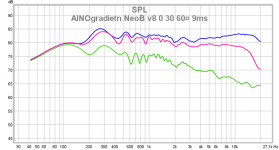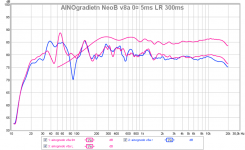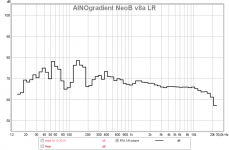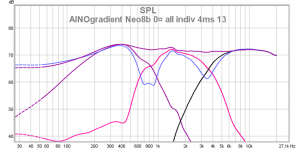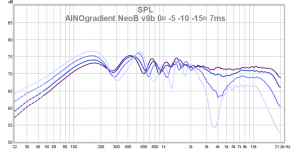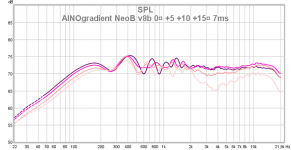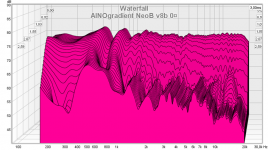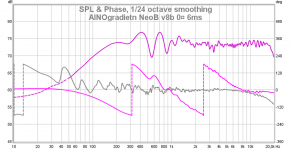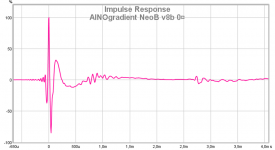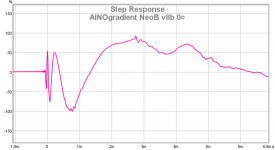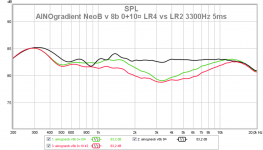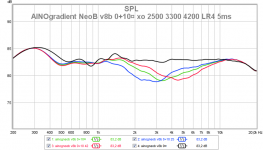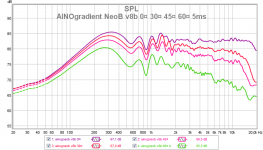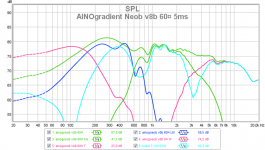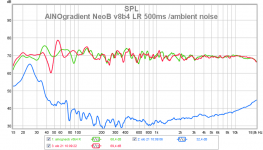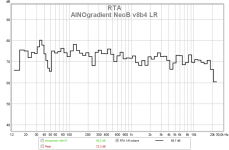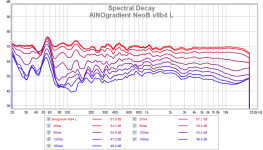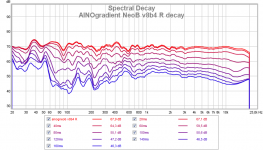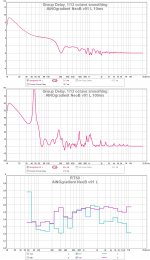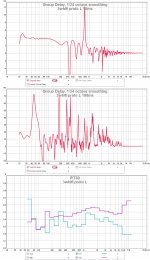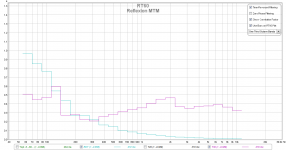Juhanus is near also the dipole roman god Janus who look at to the past and future and give us the junary month ! Summer solstice is also a dipole symbolic fest as the 18 to 21 are the longer days of the year : it's a John fest in Europe but not ypour local John who gave the Juhazi name ! Christians priest had no choice to convert locals than keeping old paganian fest !
Here it's the music fest (80's years of XX° s) : for the same reason. Remenber also than the Faun roman god of wine and music came to Delphes in Greece while Hermes come back to Hypérion at the same moment each year : also a dipole symbol !
What would you change after one year on your speaker ? a littlier 10" mid bass ? a bigger 15" sealed bass ? a serbian ribbon tweeter in dipole conf ? a sealed 8s this time for the higher mid (with an infinite sealed load _ more than 3 liters or semi resistive ?
Did you try a little resistive load by covering the back with velvet material e.g. at home ?
Good summer fest Juhazi... thanks for sharing.
Eldam
Here it's the music fest (80's years of XX° s) : for the same reason. Remenber also than the Faun roman god of wine and music came to Delphes in Greece while Hermes come back to Hypérion at the same moment each year : also a dipole symbol !
What would you change after one year on your speaker ? a littlier 10" mid bass ? a bigger 15" sealed bass ? a serbian ribbon tweeter in dipole conf ? a sealed 8s this time for the higher mid (with an infinite sealed load _ more than 3 liters or semi resistive ?
Did you try a little resistive load by covering the back with velvet material e.g. at home ?
Good summer fest Juhazi... thanks for sharing.
Eldam
Eldam,
what would I do better/different with Aino?
(Sub)Bass - LROYs rock, no sweat. Downfire gives nice boost for a sealed alignment. !" or 15" would make the box too big.
Low mid - the 12" nude is working hard and I get some mechanical resonances seen as distortion. I must try to modify it's attacment. Impulse and step response don't show anything nasty, it integrates well to planar mid.
High mid - the Neo8 is an ideal dipole midrange! only caveat is vertical c-c spacing to tweeter. I have not saved measurements of vertical off-axis (on the to-do list...) but I don't hear problems with 3,2kHz xo
Tweeter is problematic. I don't think that a neo3 or open back RAAL would be better, only different. Open back might radiaate too loud backwards and if I dampen it or the Neo8 on the backside I don't know what would happen. I have not tried backwave dampening. Perhaps I should...
Minidsp 4x10Hd is fantastic, also ICEpower amps are working fine. minidsp folks sent me instructions for pop-safe modification but I can not do it myself.
Some of latest measurements in my room.
what would I do better/different with Aino?
(Sub)Bass - LROYs rock, no sweat. Downfire gives nice boost for a sealed alignment. !" or 15" would make the box too big.
Low mid - the 12" nude is working hard and I get some mechanical resonances seen as distortion. I must try to modify it's attacment. Impulse and step response don't show anything nasty, it integrates well to planar mid.
High mid - the Neo8 is an ideal dipole midrange! only caveat is vertical c-c spacing to tweeter. I have not saved measurements of vertical off-axis (on the to-do list...) but I don't hear problems with 3,2kHz xo
Tweeter is problematic. I don't think that a neo3 or open back RAAL would be better, only different. Open back might radiaate too loud backwards and if I dampen it or the Neo8 on the backside I don't know what would happen. I have not tried backwave dampening. Perhaps I should...
Minidsp 4x10Hd is fantastic, also ICEpower amps are working fine. minidsp folks sent me instructions for pop-safe modification but I can not do it myself.
Some of latest measurements in my room.
Attachments
Hi,
Thanks for the measurements and inputs.
Do you mean you are not really happy with the LROY ? Sorry don't understand if rock, no sweat is good or not here for you ? Which QTC is the box bass according to you ?
I have to say than the little sealed load needed by the LROY is a good thing for saving space but my understanding is that the price to pay is a long excursion and low efficienty. In my case I should go to a 12" or 15" but is treated paper with lower excursion as good as heavy aluminium with higher excursion ( I think more about the transcient side here than distorsion) ? I really don't know ! SB acoustic has a beautifull 15" (expensive) with polypro material for the cone...
Maybe for your tweeter the Dayton AMT, but it said to be better not under 4000 hz !
Why not this time a neo8S as tweeter for a sweeter first or second slope with the Mid Neo 8. You can coorect all the peaks with Mini-DSP ? Or ultimatly with a futur computer EQ in digital domain before the DACS !
Yes it seems many found the MiniDSP line good enough even for a final every day speaker... I believe its might be true if you put your own I2S DAC behind it ! I surmise the quality added by curves correction an active multi amp add more SQ than a good DAC in a classic no active speaker with mono amp ! Sound tuned with the room is more important, and more than that if you include phase correction between the drivers !
I'm happy with my low efficienty speaker as the mid driver act as a near constant directivity source with its 125 hz to 2600 hz (aluminium sandwich 5" cone with passive resonator for the peaks) but hope i will have one day a more rocky and punchy speaker with higher efficienty... not to play louder but for better subjective dynamic with no less with it in the bass. Subjectivly I have it but find bigger surfaces in mid-bass and bass are a must do for no compromises...
thanks Juha, see you,
cheers
Thanks for the measurements and inputs.
Do you mean you are not really happy with the LROY ? Sorry don't understand if rock, no sweat is good or not here for you ? Which QTC is the box bass according to you ?
I have to say than the little sealed load needed by the LROY is a good thing for saving space but my understanding is that the price to pay is a long excursion and low efficienty. In my case I should go to a 12" or 15" but is treated paper with lower excursion as good as heavy aluminium with higher excursion ( I think more about the transcient side here than distorsion) ? I really don't know ! SB acoustic has a beautifull 15" (expensive) with polypro material for the cone...
Maybe for your tweeter the Dayton AMT, but it said to be better not under 4000 hz !
Why not this time a neo8S as tweeter for a sweeter first or second slope with the Mid Neo 8. You can coorect all the peaks with Mini-DSP ? Or ultimatly with a futur computer EQ in digital domain before the DACS !
Yes it seems many found the MiniDSP line good enough even for a final every day speaker... I believe its might be true if you put your own I2S DAC behind it ! I surmise the quality added by curves correction an active multi amp add more SQ than a good DAC in a classic no active speaker with mono amp ! Sound tuned with the room is more important, and more than that if you include phase correction between the drivers !
I'm happy with my low efficienty speaker as the mid driver act as a near constant directivity source with its 125 hz to 2600 hz (aluminium sandwich 5" cone with passive resonator for the peaks) but hope i will have one day a more rocky and punchy speaker with higher efficienty... not to play louder but for better subjective dynamic with no less with it in the bass. Subjectivly I have it but find bigger surfaces in mid-bass and bass are a must do for no compromises...
thanks Juha, see you,
cheers
Some more measurements, of latest v8b
Vertical directivity is a bit of a problem, due to height of Neo8. But lowerin the xo-point to 2,8 does not really help much. I measure and sit a little below tweeter axis, which is good. The vertical dip around 3-4kHz can be seen in room response (close to power response)
CSD looks fine.
Vertical directivity is a bit of a problem, due to height of Neo8. But lowerin the xo-point to 2,8 does not really help much. I measure and sit a little below tweeter axis, which is good. The vertical dip around 3-4kHz can be seen in room response (close to power response)
CSD looks fine.
Attachments
Is the - 10 db and more peak at around 3/4 k hz is verticaly ? What is the sound effect ? singer who sing seat down e.g ? Just a problem if you are not seated yourself and walk in the room ? Maybe the Neo 8 should lookk at the fllor a little more or is it just due to its length body ?
Horizontaly Il like very much the 10° curve anf find the 15° not to be a problem : do you tilt in a little your speakers ? The 0.5 to 1 db peak at 4 k hz has no effect, at home at this exact fhz i maid a narrow passive notch of -5 db but my peak was +3 db here : night & day after the change !
Bad idea from me to put a EQ Neo 8S (without its rear plate) > 2.8 k hz above your non-s Neo 8 ?
Well I'm thinking slowly as the summer is comming and I'm more involverd these time with two TDA1541 DAC project, but reading you, I'm more and more thinking about a sealed 10" for the mid-bass to match the 100 to 300 hz, at least a U-frame, but this narrow band is a problem for a filter even active (slopes to near from each other I assume !) but why not a second order to match softly with the open planar above ! Low pass filter here is harder ! maybe staying for a second order. But xo High pass of the sealed low bass (a 15" for transcient -less moves- and to match the size of the mid-bass sealed cabinet) will have a higher db, with a far lower 100 hz Xo to try to keep a first order slope !
I surmise so much problems of phase and impedance. Phase active EQ could help. The major concern would be the match of fastness between the open Neo 8 and the sealed 10" mid bass : hard transition maybe for the ears : with hybrid planars e.g. it's not really a good match most of the times.
I really want to keep your work around the open Neo8 mid-bass ans has you have many interrogations about the highs. A Raal after being heard in real life is known for a non come-back with others planars, can be xo at 3 khz (the big one), but its price is unluckily a no go for me.
To be continued, thanks again to share and for the nice measurements. Maybe try a small towel as rear load... for fun and to see... like the Brigs's Daqlqu....
regards
Horizontaly Il like very much the 10° curve anf find the 15° not to be a problem : do you tilt in a little your speakers ? The 0.5 to 1 db peak at 4 k hz has no effect, at home at this exact fhz i maid a narrow passive notch of -5 db but my peak was +3 db here : night & day after the change !
Bad idea from me to put a EQ Neo 8S (without its rear plate) > 2.8 k hz above your non-s Neo 8 ?
Well I'm thinking slowly as the summer is comming and I'm more involverd these time with two TDA1541 DAC project, but reading you, I'm more and more thinking about a sealed 10" for the mid-bass to match the 100 to 300 hz, at least a U-frame, but this narrow band is a problem for a filter even active (slopes to near from each other I assume !) but why not a second order to match softly with the open planar above ! Low pass filter here is harder ! maybe staying for a second order. But xo High pass of the sealed low bass (a 15" for transcient -less moves- and to match the size of the mid-bass sealed cabinet) will have a higher db, with a far lower 100 hz Xo to try to keep a first order slope !
I surmise so much problems of phase and impedance. Phase active EQ could help. The major concern would be the match of fastness between the open Neo 8 and the sealed 10" mid bass : hard transition maybe for the ears : with hybrid planars e.g. it's not really a good match most of the times.
I really want to keep your work around the open Neo8 mid-bass ans has you have many interrogations about the highs. A Raal after being heard in real life is known for a non come-back with others planars, can be xo at 3 khz (the big one), but its price is unluckily a no go for me.
To be continued, thanks again to share and for the nice measurements. Maybe try a small towel as rear load... for fun and to see... like the Brigs's Daqlqu....
regards
Thanks fo compliments!
Did you notice that in my previous post I show vertical directivity upwards (?) and downwards (-). My listening (0-level) axis is between M and T, that is why upwards directivity is better.
I don't hear or see any problem with matching 12" paper cone to Neo8 planar!
Did you notice that in my previous post I show vertical directivity upwards (?) and downwards (-). My listening (0-level) axis is between M and T, that is why upwards directivity is better.
I don't hear or see any problem with matching 12" paper cone to Neo8 planar!
Attachments
I have to say than I'm not able to read an impulse or step response curve in relation to an other ?!
No sorry i didn't understand that it was up and downwards ? What does it mean : the mic in front off the planar but one measure in the high and the other in the low end body ? Or between the mid and the mid bass and the other between the mid and the treble ?
At one meter ?
You mean to say the 12" is perhaps a little too big or an input of a fellow in the beginning of the thread about nude midbass who was more for a 10" if I remember correctly? I missanderstood something about vertical response and the match between the 12" and the Neo 8.
And it seems also hard to be tight without a classic OB because the vibrations (your input above, but if it's not hearble, no problem !
No sorry i didn't understand that it was up and downwards ? What does it mean : the mic in front off the planar but one measure in the high and the other in the low end body ? Or between the mid and the mid bass and the other between the mid and the treble ?
At one meter ?
You mean to say the 12" is perhaps a little too big or an input of a fellow in the beginning of the thread about nude midbass who was more for a 10" if I remember correctly? I missanderstood something about vertical response and the match between the 12" and the Neo 8.
And it seems also hard to be tight without a classic OB because the vibrations (your input above, but if it's not hearble, no problem !
Some more testing of vertical dispersion
MT vertical c-c distance is 140mm, which is actually too much, but it is impossible to make it any tighter with Neo8 and NeoCD3.5H.
Here are tests with 3300Hz LR4 vs LR2 and LR4 at 2500, 3300 and 4200Hz. Seems like 3300Hz LR¤ is the best compreomise. +10¤ at listening distance 2,5m means roughly 70cm, like sitting vs. standing up.
I also measured individual drivers at 60¤ horizontally. Directivities match well and give smooth DI.
MT vertical c-c distance is 140mm, which is actually too much, but it is impossible to make it any tighter with Neo8 and NeoCD3.5H.
Here are tests with 3300Hz LR4 vs LR2 and LR4 at 2500, 3300 and 4200Hz. Seems like 3300Hz LR¤ is the best compreomise. +10¤ at listening distance 2,5m means roughly 70cm, like sitting vs. standing up.
I also measured individual drivers at 60¤ horizontally. Directivities match well and give smooth DI.
Attachments
Hi Juhazi,
Could it be a problem to place the tweeter near the upper right or left corner of the Neo ? Acousticly a problem ? A little like Studiotech fellow maid with its neo8S and RAAL side by side in him sealde last design !
Design could be fun, asymetrical can give good looks à la Proac...
Could it be a problem to place the tweeter near the upper right or left corner of the Neo ? Acousticly a problem ? A little like Studiotech fellow maid with its neo8S and RAAL side by side in him sealde last design !
Design could be fun, asymetrical can give good looks à la Proac...
Some more tuning to get room response smoother. Lowest xo moved to 180Hz LR2, this smooths out floor bounce nulling around 200Hz. Measured L and R separately and both playing (RTA). Speakers are at normal listening position, 80cm from front wall, 30¤ toe-in, measuring distance 2,3m. Sounds good!
Attachments
A comparison of "duelundish all-LR2" vX vs. mainly LR4 v91
After some discussions about phase rotation and excess group delay I turned the present v91 xo to vX, where all four crossings are duelundish 4-pole LR2" type. However I did not do any fine tuning of acoustic responses, I just switced the XO types in minidsp control.
It is typical to LR4 to have a multi-peak step response, more phase rotation and more excess group delay than lower oder xo. However, there is discussion about the audibility of this. Each driver's directivity and distortion out of xo-point might be of more consern. The directivity of vX is much worse, but distortion is about same (not shown here). All measurements are done at 1,5m, speaker dragged in the middle of the room. 500ms/rta of v91 L/R are measured with speakers at normal listening setup, distance 2,2m.
My own listening preference is v91 (with mostly LR4). It sounds more coherent, fast (faster decay) better imaging. Frequency balance is the same. I have not had a chance to measure room response yet. My friend Legis will come here soon for aural evaluation and more measurements!
After some discussions about phase rotation and excess group delay I turned the present v91 xo to vX, where all four crossings are duelundish 4-pole LR2" type. However I did not do any fine tuning of acoustic responses, I just switced the XO types in minidsp control.
It is typical to LR4 to have a multi-peak step response, more phase rotation and more excess group delay than lower oder xo. However, there is discussion about the audibility of this. Each driver's directivity and distortion out of xo-point might be of more consern. The directivity of vX is much worse, but distortion is about same (not shown here). All measurements are done at 1,5m, speaker dragged in the middle of the room. 500ms/rta of v91 L/R are measured with speakers at normal listening setup, distance 2,2m.
My own listening preference is v91 (with mostly LR4). It sounds more coherent, fast (faster decay) better imaging. Frequency balance is the same. I have not had a chance to measure room response yet. My friend Legis will come here soon for aural evaluation and more measurements!
Attachments
-
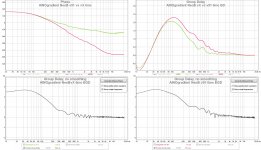 ainogneob vx vs v91 phase gd egd 6ms-tile.jpg348.2 KB · Views: 104
ainogneob vx vs v91 phase gd egd 6ms-tile.jpg348.2 KB · Views: 104 -
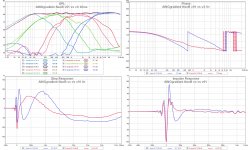 ainogneob vx vs v91 all ind 20ms imp step-tile.jpg404.6 KB · Views: 126
ainogneob vx vs v91 all ind 20ms imp step-tile.jpg404.6 KB · Views: 126 -
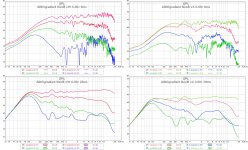 ainogneob vx vs v91 0-90¤ 6ms 20ms-tile.jpg482.1 KB · Views: 657
ainogneob vx vs v91 0-90¤ 6ms 20ms-tile.jpg482.1 KB · Views: 657 -
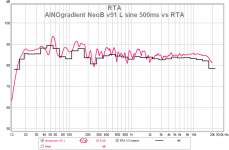 ainogneob v91 l sine500 vs rta.png67.6 KB · Views: 108
ainogneob v91 l sine500 vs rta.png67.6 KB · Views: 108 -
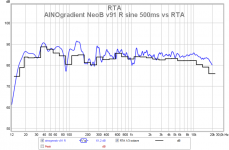 ainogneob v91 r sine 500 vs rta.png67 KB · Views: 96
ainogneob v91 r sine 500 vs rta.png67 KB · Views: 96
Some more edited measurements. Here we see (again) AINOs compared to a conventional 3-way with 2x8", 4", 1"
It amazes me how the dipole has so much less early room diffractions, seen as smoother response and smoother group delay. Another thing to notice is differencies in EDT and T30. Speaker and mic placement are the same here. The explanation lies in higher directivity and specially 90¤ where the 42" plasma tv sits between the speakers!
It amazes me how the dipole has so much less early room diffractions, seen as smoother response and smoother group delay. Another thing to notice is differencies in EDT and T30. Speaker and mic placement are the same here. The explanation lies in higher directivity and specially 90¤ where the 42" plasma tv sits between the speakers!
Attachments
Last edited:
These things, specially EDT are very much room-dependent. We can compare only those measurements that are taken at exactly same location and setup. I some of my earlier post you can find comparison of "normal" 2/3-ways vs. AINOs.
I classify speakers By directivity
- large horns, synergy horns
- Gedlee Summa/Econowave type 2-ways with compression drivers and horns
- Large 2-ways with wide waveguide tweeters
- medium/small 2-ways and 3-ways without waveguides
- dipoles well done like LX5212, NaO, my AINOs
- dipoles that loose dipole radiation above 1,5kHz
- cardioid multidrivers well done (very rare, at best By kimmosto)
Each category has typical radiation pattern, which means different sound in same room/position. Effect comes mainly from different D/R sound ratio, seen as changes in EDT and decay Graphics. Each type has it's optimal room conditions and placement. Each listener has his/her own preferences of good sound.
And finally, I believe that smooth spl response and low end capabity down to 30Hz effortlessly , low distortion and highish spl capability, are key elements of a good loudspeaker.
I classify speakers By directivity
- large horns, synergy horns
- Gedlee Summa/Econowave type 2-ways with compression drivers and horns
- Large 2-ways with wide waveguide tweeters
- medium/small 2-ways and 3-ways without waveguides
- dipoles well done like LX5212, NaO, my AINOs
- dipoles that loose dipole radiation above 1,5kHz
- cardioid multidrivers well done (very rare, at best By kimmosto)
Each category has typical radiation pattern, which means different sound in same room/position. Effect comes mainly from different D/R sound ratio, seen as changes in EDT and decay Graphics. Each type has it's optimal room conditions and placement. Each listener has his/her own preferences of good sound.
And finally, I believe that smooth spl response and low end capabity down to 30Hz effortlessly , low distortion and highish spl capability, are key elements of a good loudspeaker.
oops, I forgot! Fullrange omnis like Duevel Bella Luna are a category of their own. Then again partly omnis like LXmini...
I have omnis, medium WG 2-ways (also coax) and dipoles now. I have had or listened to synergy type horns fo Legis and several in-between type speakers and classical 3-ways.
I have omnis, medium WG 2-ways (also coax) and dipoles now. I have had or listened to synergy type horns fo Legis and several in-between type speakers and classical 3-ways.
Indeed, all sorts.
I was trying to see what you see in your T30/EDT comparing it to the last mock up measurements I have. The sub on this measurement was crossed LR4 @ 142Hz, lest all dampening material was removed for other tests. Above that point everything looks quite good, especially EDT. Not bad for an against the wall speaker. Room has no treatment which is clearly seen in impulse. First reflections occur about 4ms or so out which will be addressed with room treatments. The minimal diffraction design appears to be paying off.
I was trying to see what you see in your T30/EDT comparing it to the last mock up measurements I have. The sub on this measurement was crossed LR4 @ 142Hz, lest all dampening material was removed for other tests. Above that point everything looks quite good, especially EDT. Not bad for an against the wall speaker. Room has no treatment which is clearly seen in impulse. First reflections occur about 4ms or so out which will be addressed with room treatments. The minimal diffraction design appears to be paying off.
- Home
- Loudspeakers
- Multi-Way
- Aino gradient - a collaborative speaker project
